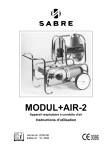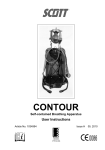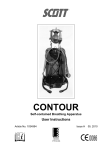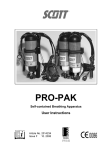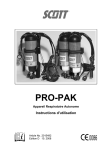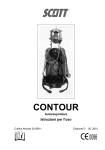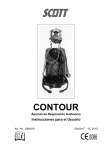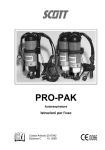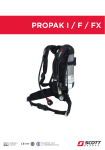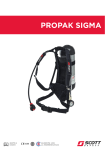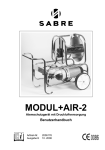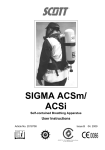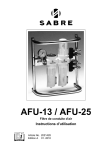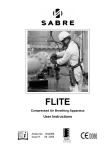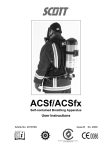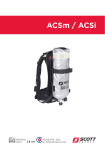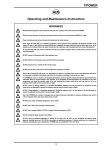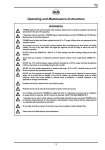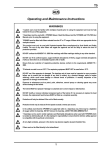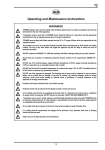Download MODUL+AIR-2 User Manual
Transcript
MODUL+AIR-2 Airline Breathing Apparatus User Instructions Article No. 1035027 Issue G 10. 2008 AS/NZS1716 : 2003 Lic. 1214 SAI Global MODUL+AIR-2 Airline Breathing Apparatus Contents WARNINGS ..................................................................................................................................................ii 1. INTRODUCTION.............................................................................................................................1 1.1 ABBREVIATIONS.......................................................................................................................1 1.2 BREATHABLE AIR .....................................................................................................................1 1.3 AIRLINE AIR SUPPLY ................................................................................................................1 1.4 APPARATUS DURATION...........................................................................................................2 1.5 TRAINING ..................................................................................................................................2 1.6 SERVICING................................................................................................................................2 1.7 SPARE PARTS AND ACCESSORIES ........................................................................................2 1.8 WARRANTY ...............................................................................................................................2 1.9 NOTIFIED BODIES.....................................................................................................................3 2. TECHNICAL DESCRIPTION ..........................................................................................................3 2.1 GENERAL ..................................................................................................................................3 2.2 PNEUMATICS ............................................................................................................................4 2.3 PRESSURE REDUCER..............................................................................................................5 2.4 HOSE REEL ...............................................................................................................................5 2.5 MEDIUM-PRESSURE ALARM OPTIONS...................................................................................6 2.5.1 Whistle ..............................................................................................................................6 2.5.2 DS4 Alarm .........................................................................................................................6 2.6 EXTERNAL AIR SUPPLY ...........................................................................................................6 2.7 AIRLINE FILTER UNIT ...............................................................................................................6 2.8 HOSE CONFIGURATIONS ........................................................................................................7 2.9 CYLINDERS ...............................................................................................................................9 3. PREPARATION FOR USE............................................................................................................10 3.1 INITIAL CHECKS - (AIRLINE SYSTEM)....................................................................................10 3.2 DS4 ALARM .............................................................................................................................10 3.3 AIR FILTER UNIT .....................................................................................................................11 3.4 INITIAL CHECKS - (CYLINDER SYSTEM) ...............................................................................11 3.5 HOSES .....................................................................................................................................11 3.6 CHANGING A CYLINDER ........................................................................................................12 3.7 ADJUSTING CYLINDER BANDS..............................................................................................12 3.8 CHANGING THE DS4 BATTERY..............................................................................................13 4. DURING USE................................................................................................................................13 4.1 EXTERNAL AIR SUPPLY WITH CYLINDER BACK-UP ............................................................13 4.2 CYLINDER SUPPLY.................................................................................................................13 5. AFTER USE ..................................................................................................................................14 6. CLEANING ...................................................................................................................................15 7. BREATHING APPARATUS LOG..................................................................................................15 8. SCHEDULED MAINTENANCE .....................................................................................................16 8.1 MONTHLY ................................................................................................................................16 8.2 ANNUALLY...............................................................................................................................16 Sabre Breathing Apparatus is a division of Scott Health and Safety Limited. Registered Office: Scott Health and Safety Limited, Pimbo Road, West Pimbo, Skelmersdale, Lancashire, WN8 9RA, England. i WARNINGS Please Read Carefully and Fully Understand This manual is for use by personnel trained in the use and care of compressed air breathing apparatus, and MUST NOT be used as a self-teaching guide by untrained users. Failure to understand or adhere to the Modul+Air-2 User Instructions may result in injury or death. Scott Health and Safety Limited have taken great care to ensure that the information in this manual is accurate, complete and clear. However, Training and Technical Support Services will be pleased to clarify any points in the manual and answer questions on Sabre breathing apparatus. The following warnings are in accordance with certifying authority requirements and apply to the use of breathing apparatus in general: Ensure that the selection of the equipment to be used is sufficient for the tasks being undertaken and the hazards likely to be encountered. For guidance on the selection of apparatus to be used with the Modul+Air-2 system, please contact Training & Technical Support Services at Scott Health and Safety Limited or refer to EN 529 : 2005 and the Health and Safety Executive Publication HS(G)53 Respiratory Protective Equipment, A Practical Guide for Users. In Australia and New Zealand, ensure that your selection of respiratory protective devices conform to the requirements of AS/NZS1715 : 1994. Anti-static supply hoses MUST be used in potentially flammable or explosive atmospheres. The equipment is designed for use in a temperature range of -6°C to +60°C. The storage temperature should be between -30°C and +60°C. When the equipment is in use, a competent person MUST remain with the supply system at all times to act as base controller and monitor the air supply. Under no circumstances must the equipment be left unmanned when wearers are being supplied from the unit. To ensure optimum equipment performance, carry out the tests and service procedures detailed in this Manual under Servicing and Scheduled Maintenance. Apparatus that fails a routine check must be withdrawn from service, an explanatory note attached and the unit returned for repair. DISCLAIMER Failure to comply with these instructions or misuse of the apparatus may result in: death, injury or material damage, and invalidate any warranty or insurance claims. COPYRIGHT This manual must not be copied in part or whole, or used for purposes other than its intended purpose without the written permission of Scott Health and Safety Limited. ii MODUL+AIR-2 Air supplied from a fixed or portable external source must be tested periodically to ensure conformance with these regulations. 1. INTRODUCTION 1.1 ABBREVIATIONS The following abbreviations are used in this manual: AFU Air Filter Unit DS4 Low Pressure Alarm DV Demand Valve m Metres mg Milligrams min Minute mm Millimetres NRV Non Return Valve PRV Pressure Relief Valve psi Pounds per Square Inch 1.2 Air supplied to breathing apparatus must be free from the odour of oil. The odour 3 threshold is in the region of 0.3 mg/m . The water content of air used to charge high-pressure compressed-air cylinders 3 must not exceed 30 mg/m for 300 bar or 3 50 mg/m for 200 bar apparatus. Air for compressed-air breathing apparatus must have a dew-point sufficiently low to prevent internal freezing when apparatus is used below 4°C. National regulations for compressed airline breathing apparatus must be observed. BREATHABLE AIR Breathable Air may be natural or synthetic. Table 1 shows the composition of natural air. Component Mass % (Dry Air) 1.3 Volume% (Dry Air) Oxygen 23.14 20.95 Nitrogen 75.52 78.08 Argon 1.288 0.934 Carbon Dioxide 0.048 0.031 Hydrogen 0.000 003 0.000 05 Helium 0.000 073 0.000 52 Neon 0.001 2 0.0001 8 Krypton 0.000 33 0.000 11 Xenon 0.000 04 0.000 009 AIRLINE AIR SUPPLY Airline systems must conform to the supply pressures and flow-rates listed in Table 2. An airline flow tester, (Article Number 1035978), can be used to check airline supply pressure and flow. Number of Wearers Pressure bar (psi) Flow (L/min) 1 5.0 - 7.0 (70 - 130) 300 2 (1 Pair) 5.0 - 7.0 (70 - 130) 450 3 (1 + 1 pair) 5.0 - 7.0 (70 - 130) 750 4 (2 Pairs) 5.0 - 7.0 (70 - 130) 900 Table 2: Airline Supply Pressure and Flow Table 1: Breathable Air - EN 12021 (NOT applicable for Australia or New Zealand) Modul+Air-2 is approved for use with a maximum hose length of 105 metres. Fire risk increases when the oxygen content is above the value shown in Table 1. The quality of air used to supply and charge breathing apparatus must conform to EN 12021 : 1999 or AS/NZS1715 : 1994. Contaminants must be kept to a minimum, and must not exceed permissible exposure levels. Where air-purifying devices are used, these must be sufficient for the types of contaminant present in the air supply. 1 MODUL+AIR-2 1.4 APPARATUS DURATION 1.6 Durations quoted for compressed-air cylinders are nominal and based on an average consumption rate of 40 litres per minute to positive-pressure breathing apparatus. Table 3 lists the cylinders approved for use with Modul+Air-2. Consumption rates are increased by the following factors: • Workload. • Temperature: extreme heat or cold. • Physical fitness: personnel, with less efficient cardiovascular systems, consume more air for a given work rate. • Stress and fatigue. • Physiological stress. • Heavy/restrictive clothing. Training and Technical Support Services at Scott Health and Safety Limited provide a complete mobile test and maintenance service for all Sabre equipment. Further details of training courses and servicing contracts can be obtained from Training and Technical Support Services. It is important that users are aware of these factors when considering the duration of air supply from cylinders, and ensure that adequate precautions are taken. 1.5 SERVICING Modul+Air-2 must be serviced at scheduled intervals by personnel who have completed a formal training course and hold a current certificate for the servicing and repair of Sabre breathing apparatus. Details of the servicing schedule are contained in the Modul+Air2 Service Manual, copies of which can only be obtained by registered holders of a current certificate. 1.7 SPARE PARTS AND ACCESSORIES Customer Services provide an efficient, friendly, customer contact point for ordering new apparatus, spare parts and accessories. The team can also provide general information on Sabre products. TRAINING Personnel using this apparatus must be fully-trained in accordance with these instructions and national regulations. 1.8 These instructions cannot replace an accredited training course run by fully qualified instructors in the proper and safe use of Sabre breathing apparatus. WARRANTY Please contact Training and Technical Support Services or your distributor for training course details. The products manufactured at our factories in Skelmersdale and Vaasa carry a warranty of 12 months (unless stated otherwise) for parts, labour and return to site. The warranty period runs from the date of purchase by the end user. Training and Technical Support Services: Scott Health and Safety Limited Pimbo Road, West Pimbo, Skelmersdale, Lancashire, WN8 9RA, England. These products are warranted to be free from defects in materials and workmanship at the time of delivery. SCOTT will be under no liability for any defect arising from wilful damage, negligence, abnormal working conditions, failure to follow the original manufacturer’s instructions, misuse or unauthorised alteration or repair. Tel: +44 (0) 1695 711711 Fax: +44 (0) 1695 711775 Evidence of purchase date will need to be provided for any claims arising during the warranty period. All warranty claims must be directed through SCOTT Customer Services and in accordance with our sales return procedure. 2 MODUL+AIR-2 1.9 NOTIFIED BODIES 2. TECHNICAL DESCRIPTION Inspec International Ltd (0194) 56 Leslie Hough Way, Salford, Greater Manchester, M6 6AJ, England. 2.1 GENERAL British Standards Institute (0086) 389 Chiswick High Road, London, W4 4AL, England. SAI Global 286 Sussex Street, Sydney, NSW 2000, Australia. Lic. No 1214. Modul+Air-2, Two-cylinder Trolley The Modul+Air-2 apparatus is a portable airline system which can supply mediumpressure breathable quality air to up-to four airline breathing apparatus with demand valves. Modul+Air-2 units are approved for use with a total hose length of up-to 105 metres. Apparatus with two reducers is approved for use with two total hose lengths of 105 metres, where each length is supplied from a reducer. Modul+Air-2 units are approved for use with all Sabre compressed-air airline breathing apparatus fitted with demand valves. The following configurations of Modul+Air-2 are available: • Static frame fitted with pneumatics and space for two compressed-air cylinders. • Static frame fitted with pneumatics and space for four compressed-air cylinders. • Trolley-based system with 2 or 4 cylinder frame, pneumatics and a hose reel capable of holding 60 metres of hose. • Trolley system with cylinders, pneumatics and a hose reel, that can be supplied from an external medium-pressure breathable air supply. 3 MODUL+AIR-2 Options for use with trolley-based versions include: • A medium-pressure warning whistle; • An Air Filter Unit (AFU); • An electronic low-pressure warning alarm (DS4). The Modul+Air-2 tubular stainless steel frame can house either two or four compressed-air cylinders (version dependent) with a diameter of between 140 mm (5.5“) and 180 mm (7”). Cylinders are secured by steel cylinder bands and butterfly catches. Modul+Air-2 is 'CE' marked to EN 139 : 1994 (Respiratory Protective Devices Compressed Airline Breathing Apparatus) and is quality-assurance approved to: ISO 9001 : 2000. Modul+Air-2 is approved to Australian/ New Zealand Standard AS/NZS1716 : 2003. Key Modul+Air-2 is marked in accordance with EN 139 : 1994 and AS/NZS1716 : 2003. An explanation of those markings is shown opposite: Meaning A= Product brand name B= Symbol - refer to User Instructions C= Operational warnings D= Contact details of manufacturer E= Product model/designation F= Apparatus description G= Standards to which apparatus is certified H= Serial number of apparatus I= Date of manufacture J= Number of Approval Body 2.2 PNEUMATICS The pneumatics system comprises cylinder connectors and reducer. Air flows from the cylinders, through the cylinder connectors to the reducer where it is reduced to between 5.5 and 11 bar. Each cylinder connector has a non-return valve that prevents air from a charged cylinder flowing into a discharged cylinder and allows discharged cylinders to be replaced while the system is pressurised. A bleed screw in the connector elbow enables the cylinder connector to be depressurised prior to disconnection. A sintered filter in the cylinder connector protects the pneumatic system from contamination. 4 MODUL+AIR-2 2.3 PRESSURE REDUCER The pressure reducer is a single stage spring and piston device with an internal pressure relief valve that protects the medium-pressure system from overpressurisation. There are ports in the reducer which accommodate: • An outlet to the medium-pressure gauge; • A medium-pressure outlet to the wearers; • The medium-pressure inlet from an external supply or an AFU (optional); • An outlet to the medium-pressure warning whistle (optional). Pneumatics for a single reducer system Air from the cylinder flows through the high-pressure manifold, enters the reducer through a jet and flows through the hollow piston stem to a chamber above the piston. As pressure in the chamber rises, the piston is forced down against the spring until the nylon seat at the lower end of the piston stem closes the jet. Pneumatics for a dual reducer system Systems designed to supply 4 wearers are provided with 2 pressure-reducers to ensure sufficient flow-rate. The reducers are connected to a common highpressure manifold. When medium-pressure air flows from the reducer to the wearers, the pressure in the chamber falls enabling the spring to lift the piston seat from the jet. This cycle continues while there is sufficient air in the cylinder. The high-pressure manifold has ports that can accommodate: • Outlets for up-to two pressure reducers; • Inlets for up-to four cylinder connectors; • An outlet for a high-pressure warning whistle; • An outlet for a high-pressure gauge. The medium-pressure gauge has a restrictor that limits air-loss to 25 litres per minute in the event of the gauge becoming damaged. 2.4 HOSE REEL The hose reel is fitted with 60 metres of 9.5 mm (3/8") bore airline supply hose. The hose conforms to EN 139 : 1994 and AS/NZS1716 : 2003; and has a maximum working pressure of 15 bar (220psi). Hoses are fitted with CEJN safety couplings. Systems that do not use all ports have blanking plugs fitted to unused ports. Medium-pressure air is output by the reducer, either directly to wearer supply airlines, or, on hose reel versions, to a manifold on the hose reel hub. The hose reel manifold can accommodate up-to two mediumpressure hoses, each from a pressure reducer; and a medium-pressure warning whistle. The high-pressure warning whistle sounds when pressure in the on-line cylinder falls below 55 bar. 5 MODUL+AIR-2 A rotatable CEJN coupling in the hub allows the hose reel to turn without loss of air. audible alarm will sound until pressure in the system reaches the safe level. Once the safe pressure level is reached, the audible alarm will cancel automatically, the red light will extinguish and a green light will illuminate. The CEJN parking connector at the top of the hose reel frame is designed to vent any pressure from the medium-pressure circuit. During use, if the medium-pressure circuit falls to below 4.5 bar (65psi), the operator is alerted by the illumination of the red warning light and the sounding of the audible alarm. Under ‘normal’ conditions, (while the pressure is at a safe level), a green light is illuminated. Anti-static hoses (which are resistant to heat and chemicals) must be used in environments where there is danger from potentially explosive or flammable atmospheres. 2.5 2.5.1 MEDIUM-PRESSURE ALARM OPTIONS 2.6 WARNING: • On Modul+Air-2 versions designed to operate with an external supply airline, the airline may be connected directly to a pressure-reducer or to an airline filter unit provided. • External air supplies must conform to EN 12021 : 1999 or AS/NZS1715 : 1994. Pressure must be between 6.0 and 9.0 bar (84 and 126psi) and capable of providing the flow-rates listed in Table 2. Whistle The medium-pressure whistle sounds when the medium-pressure circuit falls below between 4.1 bar (60psi) and 3.8 bar (55psi). 2.5.2 EXTERNAL AIR SUPPLY DS4 Alarm The DS4 alarm is a battery-operated electronic warning device which is ATEXapproved as intrinsically safe for use in flammable or explosive atmospheres. 2.7 AIRLINE FILTER UNIT DS4 Alarm The DS4 is powered by a PP3 9-volt alkaline battery, which must be renewed periodically. A yellow light will illuminate to advise the operator when the battery level is low. Airline Filter Unit (AFU) [1] [2] [3] [4] The DS4 unit is switched on and off by a key-operated switch which is located on the side of the unit, close to the warning lights. When the DS4 is initially switched on, a red warning light will illuminate and the 6 External Air Supply Inlet Pop-up Indicator Outlet Hoses Warning Whistle MODUL+AIR-2 WARNING: • The AFU WILL NOT remove carbon monoxide (CO), carbon dioxide (CO2), or other toxic gases or vapours. • The AFU MUST be operated in the vertical position. For further details, please refer to AFU User Instruction Manual. 2.8 HOSE CONFIGURATIONS Although the hose reel holds only 60 metres of hose, the maximum hose length for which Modul+Air-2 is approved is 105 metres. The total length is achieved by connecting several hoses of different lengths. The following diagrams show configurations that have been tested and approved by Scott Health and Safety Limited. The AFU has three filter elements. Two coalescing filter elements remove oil, -6 water, and particles down to 0.01 x 10 metres, giving a residual oil content of 3 less than 0.01 mg/m dirt. Configurations that result in a total length of less than 105 metres are permissible. If the maximum hose length configurations in the following diagrams do not meet your requirements, please contact Training and Technical Support Services at Scott Health and Safety Limited for advice on alternative configurations. The third element is an activated carbon absorption filter that removes oil vapour and odours. Before use, the external air supply MUST be checked for purity and composition (see Breathable Air in the Introduction section of this Manual). Where toxic gases or vapours are present, an air purifier must be used. Further details are available from Customer Services at Scott Health and Safety Limited. Auto-drain valves fitted to each element, drain water and oil filtered from the air. The third element (an absorption bed of activated carbon) removes oil vapour and odours. Elements must be renewed when congested. A red pop-up indicator on AFU is activated when the pressure drop in the AFU, caused by congestion, becomes excessive. 7 MODUL+AIR-2 Maximum hose length configuration for a 2-man Modul+Air-2 Maximum hose length configuration for a 4-man Modul+Air-2 Key: HPM = R= BA = High-pressure Manifold Reducer Breathing Apparatus 8 MODUL+AIR-2 2.9 CYLINDERS Table 3 shows the cylinder types approved for use with Modul+Air-2. All durations quoted are nominal and based on an average consumption rate of 40 litres per minute. (Composite cylinders may vary in diameter which may affect the cylinder band positions, as would the fitting of cylinder covers. The positions given are for guidance only). Table 4 contains details of the cylinder specifications. Cylinder Water volume (litres) Charging pressure (bar) Free air capacity (litres) Charged weight (kg) Total duration (min) Warning period (min) Nominal duration (min) Cylinder Band position CYL-1200 6.0 200 1200 8.8 30 8 22 3 CYL-HWG1200 6.0 200 1200 7.2 30 8 22 3 CYL-FWC1300 4.7 300 1300 5.0 32 7 25 4 CYL-1640 6.0 300 1640 5.0 32 7 33 4 CYL-HWG1640 6.0 300 1640 5.8 41 8 33 3 CYL-FWC1640 6.0 300 1640 5.8 41 8 33 7 CYL-1800 9.0 200 1800 13.0 45 12 33 14 CYL-HWG1800 9.0 200 1800 11.2 45 12 33 14 CYL-FWC1800 9.0 200 1800 6.75 45 12 33 14 CYL-FWC1860 6.8 300 1860 6.75 46 9 37 7 CYL-2240 11.0 200 2240 13.0 45 12 33 14 CYL-FWC2460 11.0 300 2460 8.8 62 12 50 14 Table 3: Cylinders approved for use with Modul+Air-2 Code Material Specification No Code Steel (eg: CYL-1200) CE Marked (EU) Work Cover (Australia & New Zealand) HWG Hoop Wrapped Glass Fibre (eg: CYL-HWG-1200) HSE-AL-HW1 (EU) Work Cover (Australia & New Zealand) FWC Fully Wrapped Carbon Fibre (eg: CYL-FWC-1300) CE Marked (EU) Work Cover (Australia & New Zealand) Table 4: Cylinder Codes and Specifications The following formulae apply: Total Duration = Nominal Duration = Warning Period = Cylinder Free Air Capacity Average Wearer Consumption Rate Total Duration minus the Warning Period Whistle Operating Pressure x Cylinder Water Capacity Average Wearer Consumption Rate High-pressure whistle operating pressure = 55 bar Please read Section 1.4 - Apparatus Duration at the front of this manual. 9 MODUL+AIR-2 3.2 3. PREPARATION FOR USE WARNING: • Keep the AFU upright during operation. Tilting the AFU may result in filtered-out material reentering the air supply. • 3.1 DS4 ALARM WARNING: The sound emitted by the DS4 alarm is VERY loud. Warn others before activating the alarm. DO NOT use apparatus that fails any of the following tests. Withdraw the unit from service, attach an explanatory note and return for servicing. INITIAL CHECKS (AIRLINE SYSTEM) 1. Check that the apparatus is clean and free from damage. 2. Check that the apparatus is complete, that the cylinders are fullycharged and that the cylinder valves and bleed screws are closed (fully clockwise). 1. Activate the DS4 alarm by inserting the key into the switch and turning the key in a clockwise direction. 2. Confirm that the red warning light illuminates and the audible alarm sounds. 3. Connect Modul+Air-2 to the external air supply. 4. Once the safe pressure level is reached, confirm that the DS4 resets from the alarm condition; (i.e. the audible alarm ceases, the red light extinguishes and the green light illuminates). 5. Ensure that the yellow light IS NOT illuminated. If the yellow light illuminates, the battery level is low and battery replacement is required. Please refer to Section 3.8 in this Manual for further details. WARNING: • DO NOT use the equipment if the yellow (low battery level) warning light is illuminated. • DO NOT remove the DS4 battery compartment cover in a potentially explosive or flammable atmosphere. 3. Check that the AFU sight-glasses are clean and dry. If required, follow the instructions given in the AFU User Manual to clean them. 4. Check that the external air supply is pressurised and that the quality of air conforms to the requirements detailed in Section 1.2 of this Manual. 10 MODUL+AIR-2 3.3 WARNING: Replace cylinders that are less than 80% full. AIR FILTER UNIT 4. Check to ensure that there are no leaks from the open bleed screw. 5. Allow 30 seconds for the system to pressurise. Close the cylinder valve and bleed screw. 6. Observe the high-pressure gauge and check that pressure loss is less than 10 bar per minute. A drop of more than 10 bar per minute indicates that there is a leak. 7. Use the DV bypass valve to bleed the system. Check that the warning whistle sounds when the high-pressure gauge reads between 50 and 60 bar. 1. Check that the AFU pop-up indicator is GREEN and that the medium-pressure gauge needle is in the green sector. 2. 8. Repeat operations 1 to 6 for each of the remaining cylinders in turn. Note: Ensure that air is drained through the DV bypass valve before commencing tests on next cylinder. Listen for audible leaks from the unit. 3. Follow the instructions given in the breathing apparatus User Manual and connect the breathing apparatus pigtail and facemask(s) to the airline hose(s). Pull the connections firmly to ensure that they are secure. 9. breathing apparatus 4. On ALL connected, turn the DV bypass valve(s) to the ‘ON’ position. With air free-flowing from the DV(s), check that the medium-pressure gauge stays in the green sector and that the DS4 does not alarm. 11. Turn the DV bypass valve(s) to the ‘OFF’ position and check that air no longer flows from the DV(s). 5. Turn the DV bypass valve(s) to the ‘OFF’ position and check that air no longer flows from the DV(s). 12. Follow the instructions in the breathing apparatus User Manual to check the facemask, DV and pigtail. 6. Perform all pre-use checks detailed in the User Manual of the breathing apparatus to be used with Modul+Air-2. 3.4 Open one cylinder valve fully. breathing apparatus 10. On ALL connected, turn the DV bypass valve(s) to the ‘ON’ position. With air free-flowing from the DV(s), check that the medium-pressure gauge stays in the green sector and that the medium-pressure whistle does not alarm. 3.5 INITIAL CHECKS (CYLINDER SYSTEM) HOSES 1. Examine all hoses for signs of damage such as splits, abrasions and deep crazing (minor crazing is acceptable). 1. Check that the cylinder connector(s) is/are connected to the cylinder valve(s) and that all bleed screws are closed. 2. Examine all couplings for signs of damage and ensure that all connections are securely made. 2. Open the bleed screw OPPOSITE the cylinder to be tested. WARNING: DO NOT use hoses or couplings that exhibit signs of damage. 3. Open the cylinder valve to be tested and check that the high-pressure gauge shows at least 80% full. 11 MODUL+AIR-2 3.6 catch 90° clockwise and folding the catch flat. (Minor adjustments can be made using the cam-lock fastener: turn clockwise to tighten and anti-clockwise to loosen). CHANGING A CYLINDER WARNING: • DO NOT mix cylinders of different charging pressures when using the equipment. Fit only FULLYCHARGED cylinders. • When a cylinder is changed while the apparatus is in use, ensure that an adequate supply of air is available in the on-line cylinder for breathing apparatus wearers. • 8. On the replacement cylinder, open the cylinder valve the close the on-line cylinder valve. Check that the highpressure gauge reading is at least 80% full. 3.7 ADJUSTING CYLINDER BANDS To prevent possible equipment failure, DO NOT charge the pneumatic system utilising more than one cylinder or operate the Modul+Air-2 system with more than one cylinder valve open. 1. On the empty cylinder, release the hand-wheel locking catch and close the cylinder valve (A). [1] [2] [3] [4] Cylinder Band Retaining Screw Cradle Flap Locking Catch 1. Use a 4mm Allen Key to remove the cylinder band retaining screw and release the cylinder band. 2. Open bleed screw (B) to vent the cylinder connector. Close the bleed screw and disconnect the cylinder connector from the cylinder. 2. Re-position the cylinder band according to the hole-positions given in Table 3. Replace the retaining screw and tighten securely. 3. With the frame in a horizontal position, release the cylinder band catch and remove the cylinder. 4. If the replacement cylinder is of a different size, adjust the cylinder band accordingly (see Section 3.7 - Adjusting Cylinder Bands). 5. Slide the charged cylinder into the frame, ensuring that it is correctly located against the end of the frame. 6. Fit and securely tighten the cylinder connector. 7. Position the cylinder band around the cylinder and secure by turning the butterfly 3. Position the cylinder in the frame and fasten the cylinder band butterfly catch. 12 MODUL+AIR-2 3.8 CHANGING THE DS4 BATTERY 4. DURING USE WARNING: When in use, a competent person MUST remain with the supply system at all times to act as base controller and monitor the air supply. Under NO circumstances must the equipment be left unmanned when wearers are being supplied from the unit. WARNING: DO NOT remove the DS4 battery compartment cover in a potentially explosive or flammable atmosphere. 1. Remove the four screws that secure the battery compartment cover to the DS4 unit. Place battery compartment cover aside. 4.1 2. Withdraw the battery and holder from the battery compartment. 3. Remove the battery from the holder. EXTERNAL AIR SUPPLY WITH CYLINDER BACKUP If the low-pressure alarm sounds (DS4 or medium-pressure whistle), or if the medium-pressure gauge falls below 5 bar: 4. Replace the battery in the holder and refit into the battery compartment. 5. Replace the battery compartment cover and secure in position with the four screws. Tighten screws evenly, DO NOT over-tighten. 1. Fully open one cylinder valve. 2. Check that the high-pressure gauge reading is greater than 80% and that medium-pressure gauge is above 5 bar. 3. If required, disconnect the external air supply. 4.2 CYLINDER SUPPLY If the high-pressure sounds: warning whistle 1. Open the next designated cylinder valve fully. 2. Close the cylinder valve and open the bleed screw on the empty cylinder. 3. Follow the instructions in Section 3.6 to replace the empty cylinder. 4. Mark the empty cylinder accordingly and store separately from full cylinders. 13 MODUL+AIR-2 5. AFTER USE The following procedure covers all options available with Modul+Air-2 and covers the apparatus in general. 1. Close the cylinder valve and open the bleed screw on the active cylinder. 10. Connect the hose CEJN outlet to the parking connector on the hose reel. This prevents the hose unwinding and vents any pressure left in the medium-pressure circuit. 2. Switch off the DS4 unit by turning the key in a counter-clockwise direction. 3. Disconnect the external air supply. 4. Open the breathing apparatus bypass and vent air from the pneumatics. 5. Replace used cylinders with fullycharged cylinders. 6. Disconnect the breathing apparatus from the airline. Clean, test and inspect the breathing apparatus in accordance with the appropriate User Manual. 7. Examine hoses for damage or excess wear such as splits, kinks and abrasions. Replace damaged or worn hoses. 11. Firmly grasp and pull the winding handle knob away from the hose reel. Fold the knob against the handle. 8. Examine all couplings for wear or damage and ensure that all connections are securely made. Replace items with worn or damaged connectors. 9. Rewind the airline hose onto the hose reel. 14 MODUL+AIR-2 6. CLEANING 7. BREATHING APPARATUS LOG CAUTION: Do not drop the hose ends onto the floor as this may damage the couplings. A breathing apparatus Log must be maintained for each apparatus and must be retained for future reference. 1. Clean all parts of the apparatus with a mild soap and water solution, followed by a thorough rinse with clean water. Unwind the hose to ensure that all parts are cleaned. A breathing apparatus Logbook, is available from Scott Health and Safety Limited (under Article Number 1034745) for this purpose. 2. Allow to dry away from direct heat. Dry the air-hose thoroughly prior to rewinding onto the reel. The log must contain: • Name and address of the employer responsible for the apparatus. • Name and signature, or unique authentication, of the person conducting the tests. • Manufacturer, model and serial number of the equipment, together with details of any other distinguishing features or markings that enable it to be clearly identified. • Condition of equipment and details of any faults found during the tests, and any remedial action taken. • Types of test conducted. • Date of the tests. • Air pressure within the cylinders. • The length of time that the equipment was in use must be recorded (for AFU servicing requirements). 3. Inspect all parts of the apparatus for damage and check the function of CEJN hose couplings. 4. Follow the cleaning instructions given in the breathing apparatus, DS4 and AFU User Manuals. 15 MODUL+AIR-2 8.2 8. SCHEDULED MAINTENANCE 8.1 ANNUALLY 1. The equipment must be tested and serviced in accordance with the Modul+Air-2 Service Schedule, within a maximum period of one year. MONTHLY 1. The equipment must be checked and tested at monthly intervals in accordance with the After Use instructions contained in this Manual. 2. Full details of servicing requirements can be found in the Modul+Air-2 Service Manual, which is available from Training and Technical Support Services at Scott Health and Safety Limited upon completion of a formal training course in maintenance of the apparatus. 2. Details of these tests must be recorded within the appropriate register and retained for future reference. Note: In the United Kingdom, monthly testing is a statutory requirement under COSHH (Control of Substances Hazardous to Health) regulations. 3. In order to maintain correct functioning of the equipment, if it is subjected to excessive use, it may be necessary to test the equipment on a more frequent basis than that stipulated. 16 Sabre Breathing Apparatus Scott Health and Safety Limited Pimbo Road, West Pimbo, Skelmersdale, Lancashire, WN8 9RA, England. Tel: +44 (0) 1695 711711 Fax: +44 (0) 1695 711775




















